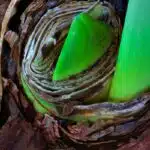Silver Squill is a rare, yet surprisingly easy-to-care-for flower that has been known to bring beauty and life to even the most barren of gardens. With its striking silver foliage and delicate white flowers, it’s no wonder why this plant has become increasingly popular among gardeners around the world. For those looking to add a touch of elegance to their outdoor space, Silver Squill may be the perfect choice.
As botanists and gardening specialists know, taking care of any flower requires knowledge and attention. Silver Squill is no different – with the right care, it can thrive in almost any environment. From providing proper sunlight exposure to fertilizing regularly, there are several key steps involved when growing and caring for this unique flower.
Fortunately, taking care of Silver Squill doesn’t have to be overly complicated; with some basic information and guidance from experts like us, anyone can become an expert in growing these beautiful specimens in their own home. In this article we’ll provide comprehensive tips for growing and caring for Silver Squill so that your garden can reach its full potential!
What Is Silver Squill?
Necessity is the mother of invention,” and this is certainly true when it comes to growing silver squill. Silver squill, also known as Drimia maritima, is a perennial flowering plant that produces vibrant purple flowers in warmer climates. It thrives in sandy soil and can tolerate drought-like conditions. If you’re looking for a beautiful addition to your garden, silver squill is an excellent choice!
When caring for silver squill, it’s important to keep a few things in mind. Silver squill prefers full sun and well-draining soil. If the soil remains too moist for too long, it can cause root rot in the plant. To ensure proper drainage, mix some compost into the soil before planting your silver squill. Additionally, you should water your silver squill regularly during dry spells and make sure to remove any dead or wilted foliage.
Silver squill is an easy-to-care-for plant that adds beauty to any garden. With its unique purple blooms and its ability to thrive in challenging climates, it’s no wonder why silver squill has become a popular choice among gardeners around the world! Now that we’ve discussed how to care for this stunning flowering plant, let’s explore where it’s best planted.
Where To Plant Silver Squill
Silver squill is a unique and exotic plant, one that requires a special kind of care in order to flourish. As such, it’s important to know the best place to plant the silver squill if you want it to thrive. With some knowledge and effort, you can give your silver squill the environment it needs to grow.
First and foremost, silver squill should be planted in an area that receives partial sun or full shade. This will ensure that the plant gets enough sunlight for photosynthesis but also its leaves don’t become scorched by too much heat from direct sunlight. To ensure optimal growth, aim for an area with temperatures between 45-75 degrees Fahrenheit during the day and 40-60 degrees at night.
When it comes to soil requirements, silver squill prefers well-draining but moist soil with a neutral pH level of 6-7. Adding compost or peat moss can help create a richer soil mixture that retains moisture better while still allowing excess water to drain away effectively. Additionally, adding fertilizer every few weeks during the growing season will provide extra nutrients for your silver squill so it can reach its full potential.
Taking the time to properly prepare your planting site is essential for providing your silver squill with the ideal environment for growth and health throughout its lifespan. Keeping this in mind as you embark on your journey into gardening with silver squill will result in an abundance of beautiful blooms each spring!
Soil Requirements For Silver Squill
Silver squill is a beautiful, low-maintenance bulbous plant that can bring a unique beauty to any garden. It’s easy to care for and, with the right soil requirements, will flourish in most climates. Here are some tips on how to make sure your silver squill thrives.
Firstly, silver squill needs well-draining soil in order to thrive. The best type of soil is a sandy loam; however, it can also grow in clay or silt soils if they are amended with organic matter such as compost or peat moss. It also prefers neutral soils, so you may need to add lime if your soil is too acidic. Here are some things you should keep in mind when selecting the right soil for your silver squill: • Add plenty of compost or peat moss to amend heavy soils. • Do not use fertilizers other than compost or manure; synthetic fertilizers can damage the roots of the plant. • Make sure that the soil has good drainage; standing water can cause root rot which will kill the plant.
When planting silver squill bulbs, make sure that they are planted at least 8 inches deep and 6 inches apart from each other. This will ensure that they have enough room to spread out and get all the nutrients they need from the soil. You should also place a layer of mulch over them when planting to help keep weeds away and retain moisture around their roots. As an added bonus, mulching will also help insulate them during colder weather months so that your bulbs won’t freeze and die off prematurely!
Now that you know how to prepare your soil for silver squill, it’s time to move on to another important factor: sunlight requirements!
Sunlight Requirements For Silver Squill
Silver squill requires a significant amount of sunlight for its proper growth and development. It should be planted in an area that gets full sun or at least six hours of direct sunlight daily. This will help the plant produce more flowers, making it look attractive and healthy.
In addition to this, silver squill can also tolerate partial shade but it is important to ensure that it receives enough light for its growth and flowering. When planting silver squill, make sure to place it away from trees or other large plants which can block the sunlight from reaching the plant. Furthermore, if the soil around the plant is too dry, then it may be necessary to water the soil more frequently or shade the plant during hot summer days.
The right balance of sunlight is essential for silver squill’s health and growth; too much sun exposure can cause leaf scorch while insufficient light will cause weak stems and fewer flowers. To get the most out of your silver squill, make sure to provide it with adequate sunlight so that it looks attractive and lush throughout the growing season. Now let’s look into how much water this amazing plant needs in order to thrive!
Water Requirements For Silver Squill
Silver squill is an attractive and low-maintenance bulb that adds a splash of color to any garden. Like all plants, however, silver squill requires the right amount of water to stay healthy. Knowing when and how much to water your silver squill will ensure it grows and blooms abundantly each season.
When it comes to watering, silver squill should be kept consistently moist but not overly saturated. Aim for about 1 inch of water per week during the growing season and reduce this if you experience heavy rains in your area. During dormancy—typically from late fall to early spring—allow the soil to dry out completely between waterings. To check soil moisture levels, insert your finger into the soil up to the first knuckle; if the soil is damp at this depth, no additional watering is needed.
To encourage healthy growth, consider using a soaker hose or drip irrigation system around your silver squill bed. This will help keep the foliage dry while still providing adequate moisture for optimal root growth. Additionally, mulching with organic matter such as shredded bark or compost can help retain moisture in the soil while also controlling weeds. With proper care and attention, you can ensure your silver squill continues to thrive well into the future.
Fertilizing Silver Squill
The best of gardens are fed and tended to with care” is an adage that rings true when it comes to growing silver squill. Fertilizing the plant is a key step in ensuring its health and growth, as the nutrients in fertilizers provide essential nourishment for the soil. As a specialist in botany and gardening, I’m here to guide you on how best to fertilize silver squill.
Silver squill requires very little fertilizer; a light application of a slow-release fertilizer every 3-4 months should suffice. If your soil is rich in natural nutrients, then you may not need any additional fertilizer. It’s best to apply the fertilizer during spring or summer when the plant is actively growing, which will ensure that the roots take up all of the nutrients provided by the fertilizer. You can also use liquid fertilizers; however, these should be applied more frequently (every two weeks) at half strength than what’s recommended on the package.
It’s important not to overfertilize silver squill – too much fertilizer can burn its roots and lead to poor growth or death. When applying fertilizer, make sure it’s distributed evenly around the base of the plant and not directly on top of its leaves or stems. Additionally, water thoroughly after fertilizing so that all of the nutrients are absorbed by the soil. With proper fertilization techniques, your silver squill will thrive!
By providing your silver squill with balanced levels of nutrients through regular fertilization, you’ll be on your way to propagating healthy plants for years to come!
Propagating Silver Squill
Silver squill is a beautiful and interesting species of bulbous perennial, which is native to southern Europe and parts of Africa. Propagating it can be an exciting process, as it can be done both vegetatively and through seed.
Vegetative propagation involves dividing the bulbs or taking stem cuttings. The bulbs should be divided in the early spring when they are actively growing. Plant each division into a well-drained soil mix with plenty of organic matter for optimum growth. Stem cuttings should also be taken in early spring and planted in moist potting soil immediately.
When propagating from seed, it is important to select seeds that are fresh, as old seed will not germinate properly. Plant the seeds in trays filled with a light soil mix during late winter or early spring. Keep the seedlings moist and place them in bright, indirect light for best results. Transplant them outdoors when they reach about 2 inches tall or when temperatures become warm enough outside for them to survive.
Propagating silver squill is a rewarding project that can bring many years of enjoyment and add beauty to any garden bed if done correctly. With proper care and attention, this species has the potential to grow into a large clump of blooms that will last through springtime each year!
Controlling Pests And Diseases On Silver Squill
Silver squill is a low-maintenance perennial that, with proper care, can thrive for many years. Unfortunately, it can be vulnerable to pests and diseases. According to the National Gardening Association, 69% of gardeners experience pest and disease issues in their gardens. As such, controlling these problems on silver squill should be a priority for botany and gardening enthusiasts.
The first step in controlling pests and diseases on silver squill is preventive maintenance. Keeping weeds away from the plant will reduce the chances of unwanted insects feeding on it. Also, regular irrigation will ensure that the soil stays moist but not soggy as wet soil encourages fungal growth which may cause root rot. Additionally, applying compost or fertilizer will help enhance the fertility of the soil and make it less prone to pest infestations.
Finally, if your silver squill has already been affected by pests or diseases, then you should act quickly to avoid further damage. Identifying the exact pests or disease causing issues can be tricky so consulting an experienced gardener or using online resources can help narrow down potential causes. Once identified, follow appropriate treatments to mitigate them as soon as possible; this may include chemical pesticides or organic solutions such as neem oil depending on the severity of the problem.
To effectively keep your silver squill healthy, it is important to stay vigilant against pests and diseases by following preventive measures and taking quick action when needed.
Deadheading Silver Squill
Deadheading silver squill is a simple process that helps to keep the plants looking their best. It involves removing spent blooms to encourage new growth and continuous flowering. According to research, deadheading can increase the amount of flowers produced by up to 50%. Botanists and gardeners agree that this practice can help create more attractive displays of color in any garden.
Deadheading should be done when the flowers have gone past their peak, which is usually after they start fading and turning brown. The spent flower heads can then be carefully snipped off with sharp scissors or pruning shears, making sure not to damage any of the surrounding foliage. If there are seed pods present, these should also be removed at the same time to prevent self-seeding and promote a tidier appearance.
Regular deadheading will keep silver squill looking neat and tidy, while providing an abundance of flowers throughout the growing season. Since silver squill are drought tolerant, it’s important to remember not to over-water them as this can cause fungal diseases that may compromise their health and longevity. With proper care, these hardy plants will reward you with beautiful blooms for years to come!
How To Divide Silver Squill
When it comes to silver squill, dividing is an important step in proper care. This can be done when the bulbs become overcrowded or if you want to propagate new plants. Dividing silver squill requires a bit of patience and finesse since the bulbs are quite fragile. Here are some steps to help you successfully divide your silver squill:
Begin by removing the plant from the soil. Take care not to damage the roots while doing so.
Shake off any excess soil and inspect the bulbs for signs of rot or disease. Discard any sickly looking bulbs and set aside healthy ones for replanting.
Gently separate the bulbs with your fingers, taking care not to break them apart too harshly. Each section should contain at least one growing point, or scape, in order for replanting to work properly.
Plant each bulb section into its own pot filled with well-draining potting mix, making sure each bulb is firmly in place and that it has enough space to grow without becoming overcrowded again.
Water regularly as needed and keep an eye out for signs of distress or disease on your newly divided plants.
With a little time and effort, you can successfully divide silver squill and enjoy a greater abundance of beautiful flowering plants in your garden! It’s important to pay close attention when dividing silver squill since mishandling can lead to irreversible damage to the delicate bulbs. Once divided properly, however, you will have plenty of healthy new plants ready for replanting in no time!
When To Harvest Silver Squill
Harvesting silver squill is the ultimate reward of growing this beautiful plant. It’s a moment where your efforts come to fruition, and you can experience the joy of harvesting something you’ve nurtured with your own hands! As a specialist in botany and gardening, I’m here to guide you through this process so that you can reap the rewards.
When it comes to harvesting silver squill, timing is everything. The plants typically bloom for about two weeks each year during the late spring or early summer months. You’ll know it’s time to harvest when the flowers have started to wither and fade away from their vibrant hue. It might be tempting to wait until all the blooms have withered before harvesting, but doing so will result in fewer seeds for replanting.
So as soon as you notice that the flowers have started to wither away, it’s time to take action! Gently pluck off each seed pod from the stem and place them in an open container or envelope that will allow air circulation. Make sure not to leave too much moisture on them, as this can cause mold or mildew growth. Allow them to dry out fully before storing them in a cool and dark place until they’re ready for replanting next season.
With these steps in mind, you can now enjoy your bounty of silver squill seeds! Use these tips as a guide for harvesting this delightful flower every year, so that you can continuously enjoy its beauty in your garden!
Using Silver Squill In The Garden
The use of silver squill in the garden is a great way to add a splash of colour, while also providing a variety of benefits to the landscape. This small plant can be used as an effective groundcover or as an accent around trees and shrubs. With its delicate white flowers and attractive grass-like foliage, it adds beauty and interest to any setting. As with all plants, though, it’s important to know how to care for them correctly so they will thrive.
Silver squill requires full sun in order for it to reach its full potential. It should be planted in well-drained soil that has been amended with organic matter such as compost or manure. Watering should be done regularly during dry spells, but you should avoid overwatering since this can lead to root rot and disease. If you’re growing silver squill in containers, make sure that the potting mix is kept moist but not soggy. Additionally, fertilizing every few months will help promote healthy growth and blooming.
A key component of caring for silver squill is knowing when to harvest it from the garden; this should be done after the flower petals have begun to fade away and the seedheads are beginning to form. During the winter months, you’ll want to mulch heavily around your plants in order to protect them from freezing temperatures or heavy winds. With proper care and maintenance, silver squill can bring years of enjoyment into your garden – making it a worthwhile addition whether used alone or alongside other plants!
Container Growing Silver Squill
- Container Growing Silver Squill Belonging to the Hyacinthaceae family, silver squill is a flowering bulbous perennial that can create an interesting addition to any garden or container display. According to research, it’s one of the most popular flowering plants in gardens in Northern Europe. Let’s look at some considerations for growing these lovely flowers in containers:
Firstly, one must choose a suitable pot and soil. A pot with good drainage is essential; you should use a soil-based compost such as John Innes No 2 with added perlite or grit to ensure adequate drainage. You should also add slow-release fertiliser at this time.
Secondly, it’s important to keep the soil damp but not soggy when planting silver squill bulbs and this will require regular watering during their growing season. Points to remember are: • Provide enough water to moisten the soil without over-watering • Ensure containers have adequate drainage holes • Water from below where possible • Feed with liquid feed every two weeks throughout their growing season • Allow soil surface to dry out between watering Thirdly, silver squill bulbs need plenty of sunlight so position them somewhere that receives six hours of sun each day and consider moving them indoors if there’s too much wind exposure outdoors. Additionally, ensure they are planted at least 8 inches apart in order for them to thrive and develop properly. Now that we’ve looked into how we can grow silver squill in containers, let’s explore how they can be stored over winter months.
Storing Silver Squill Over Winter
It is often thought that the Silver Squill requires careful winter storage in order to ensure it thrives come spring. But is this really the case? Let’s investigate.
The Silver Squill is a hardy bulb that can survive through most winters with minimal effort. That being said, they will benefit from some extra protection and care during the cold months. Storing Silver Squill over winter includes using a dry, well-ventilated area with temperatures around 45°F (7°C). This can be achieved by placing them in an unheated attic or basement. Additionally, you should clean off any excess dirt and allow them to dry before storing them in paper bags or cardboard boxes filled with peat moss or sand.
Finally, if stored correctly, the bulbs should remain dormant until spring when they can then be planted in well-drained soil and watered regularly. Doing this ensures that your plants will have a healthy start to the season and will flourish for years to come.
Troubleshooting Silver Squill
Troubleshooting silver squill is like solving a jigsaw puzzle. It requires patience, keen observation and a proper diagnosis of the problem in order to find the right solution for any given situation. As a specialist in botany and gardening, I understand that silver squill can be tricky to care for, but with the right knowledge and guidance, you can easily keep your plant healthy.
One of the most common problems involving silver squill is root rot or fungal diseases. To avoid this issue, ensure that your soil drains well and never overwater your plants. In addition, regularly check for signs of white powdery mildew or spots on the foliage – they could be indications of an impending fungal attack. If you spot any symptoms, treat them immediately with fungicide treatments or other organic solutions.
Finally, silver squill may also suffer from insect infestations such as aphids or mites. To prevent this, ensure that your plants are kept clean by removing dead and decaying leaves periodically. Additionally, inspect new cuttings before introducing them into your garden to avoid any unwanted pests hitching a ride! With a little bit of extra care and attention, you can help keep your silver squill thriving all year round – allowing you to enjoy its unique beauty for many years to come!
Frequently Asked Questions
What Is The Best Way To Winterize Silver Squill?
To keep silver squill thriving during the cold months, it’s important to winterize them properly. Like a well-stocked bunker, a little preparation can go a long way in ensuring these hardy plants survive the harsh winter. Let’s explore the best ways to make sure your silver squill is ready for whatever Mother Nature throws at them.
Like a soldier headed for battle, protecting your silver squill requires arming it with insulation and proper covering. Mulch around their base and water them thoroughly before temperatures drop too low. This will help ensure they have enough moisture to get through an especially chilly stretch of days or nights. Additionally, if you plan to move your silver squill indoors, then place them near a south-facing window where they can receive plenty of light and warmth during the day.
As the saying goes – opposites attract – so don’t forget to move your potted silver squill away from any heat vents or radiators as this could cause their leaves to dry out. Keeping an eye on their environment is key as any sudden change in temperature could cause them harm. If you find that they are still struggling after winterizing, then don’t be afraid to give them some extra TLC in the form of fertilizer or trimming their foliage back until warmer weather returns.
Winterizing silver squill requires vigilance and preparation. With just a few simple steps, you can make sure that your plants are ready for anything that comes their way this season!
How Often Should Silver Squill Be Watered?
Silver squill is a unique and attractive flower that is relatively easy to grow in most areas. When cared for properly, it can provide bright blooms year after year. Watering is an important part of successful silver squill care.
Silver squill needs to be watered regularly during its active growing season, which generally starts in late spring and ends in early fall. During this time, the soil should be kept consistently moist but not soggy. Depending on your local climate, you may need to water your silver squill every few days or even daily during dry weather conditions. If you have mulch around the plant, this will help retain moisture in the soil and make watering less frequent.
When winter arrives, reduce watering significantly as silver squill goes dormant until springtime. During this period, check the soil periodically to ensure it is not completely dry; if necessary, give your plant a light sprinkle of water every couple weeks or so.
TIP: After planting silver squill in your garden or container, keep an eye on the weather forecast and adjust the frequency of watering accordingly.
Does Silver Squill Attract Wildlife To The Garden?
Ah, silver squill. A delightful addition to any garden, adding a splash of colour and life that can transform even the dullest of spaces. For those looking to attract wildlife to their gardens, it’s an ideal candidate — but does it hold the same appeal to our feathered friends?
The answer is a resounding yes! Silver squill is a great way to encourage birds and other creatures into your garden. The foliage provides cover and protection, while its bright flowers offer nectar for birds and insects alike. It’s also low-maintenance, requiring little more than regular watering; making it an excellent choice for busy gardeners.
As far as taking care of them goes, they’re not particularly fussy; simply water them when the soil begins to dry out and snip off any dead flowers or leaves as needed. The added bonus with silver squill is that they are fairly tolerant of neglect; so if you don’t have time for regular maintenance, you’ll still be able to enjoy their presence in your garden without having to worry about them dying off.
In summary, silver squill not only adds a flourish of colour and texture to any outdoor space, but it also helps make your garden more attractive to wildlife too! With minimal effort required on your part, you can make your garden an inviting haven for both animals and humans alike.
Are There Companion Plants That Work Well With Silver Squill?
Silver squill is an attractive and versatile plant that can be incorporated into any garden. It’s important to consider the companion plants you choose to grow alongside it, as some may enhance its growth while others could prove detrimental.
When considering companion plants for silver squill, a good rule of thumb is to look for other Mediterranean-type plants with similar growing requirements. Planting silver squill with perennial flowering bulbs like daffodils or snowdrops will help fill out the area and add variety in color and texture. Other suitable companions include lavender, rosemary, grasses, and irises.
It’s important to give careful consideration when selecting companion plants for your silver squill. Choosing those that are appropriate for your climate zone and have similar growing needs will help ensure success in creating a thriving garden environment for your silver squill. With the right combination of companions, you can create a beautiful display in your garden that will last for years to come!
Does Silver Squill Require Regular Pruning?
Pruning is an essential part of caring for silver squill and it requires regular attention. Silver squill, or Scilla peruviana, is a Mediterranean herbaceous perennial that produces beautiful star-shaped, blue flowers in early spring. This plant can grow up to 12 inches tall and its foliage will become quite dense if not pruned regularly. Pruning should be done when the plant has finished blooming and should be done by cutting back the flower stems to just above where leaves are emerging from the soil. This will encourage new growth and promote flowering in subsequent years.
Pruning silver squill can also help to maintain the size of the plant, as it can spread quickly when left unchecked. To do this, simply remove any shoots that have grown too tall or wide for the desired size of your garden bed or pot. While you don’t want to over-prune your silver squill, some pruning may be necessary in order to keep its shape and size under control. It’s also important to remove any dead or diseased foliage throughout the year.
The best time of year for pruning silver squill is late winter or early spring before new growth begins. During this period, you’ll want to carefully inspect each stem of your plant and determine which ones need trimming back in order to encourage healthy blooming and prevent overcrowding. When pruning, make sure to use sharp gardening shears so as not to damage any existing stems or foliage on the plant. With proper care and regular pruning, your silver squill will thrive and bring beauty into your garden!
Conclusion
Silver Squill is a stunning plant that can add a unique charm to any garden. Its silver-green foliage and delicate white flowers make a beautiful backdrop for other plants. Not only does it look attractive, but Silver Squill is also low maintenance and requires minimal care to thrive. With the right winterizing techniques and regular watering, Silver Squill will provide years of beauty in your garden.
Caring for Silver Squill is like tending to any other plant in your garden: you want to keep it healthy and vibrant so that it can reach its full potential. Knowing when to prune, how often to water, and what companion plants work well with Silver Squill will help ensure success in your gardening endeavors.
In many ways, caring for Silver Squill is like caring for us all; we must nurture each other’s growth if we are to achieve our goals. By taking the time to properly winterize, water, and prune our plants, we can create an environment where everyone flourishes just as Silver Squill does in the garden.





























